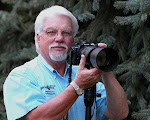
The heartbeat of the forest began in full darkness each morning of the past two weeks as I sat in a photography blind near a ruffed grouse drumming log. Daily at 05:30 the initial "Thump- Thump-Thumps" of the male grouse's powerful wings brought my senses to full alert as his drumming built to the full crescendo of roaring wings.
Hearing his dainty foot steps as he approached his drumming throne, in the darkness of successive starlight nights, was thrilling. Silence meant that he'd mounted the log and that his successive concussions of drumbeats would begin momentarily. The thumps of his wings pulsed upon my eardrums and seemed to impact my entire body, like heavy musical bass notes from a speaker.
Unable to see him, just a few feet away, I elected to time his drumming cycle and the rest periods between audio displays. From the initial thump to completed crescendo, nine seconds transpired; it never varied. Rest periods between drumming displays were either 1 minute and 50 seconds or 1 minute and 10 seconds. Once set, these intervals also did not vary daily.
As the sun gradually lit the scene, I marveled at his diligence and beauty that appeared to increase in response to the brightening light. By 07:15 sufficient light to trip the Nikon's shutter existed and at 07:45, the glorious bird displayed in a natural spotlight. Shutter speeds increased in response to the brightening light and shooting the 300mm, 2.8 lens (wide open) enabled gradual adjustments of shutter speeds to take best advantage of the sun's intensity.
In forest wildlife photography, rarely are shutter speeds of 1000/sec and greater attainable, but in this situation, the bird's chosen display area was often awash with sufficient ambient light to permit 1600/sec shutter speeds. Shooting with such FAST light was like driving a Ferrari.
Between drumming sequences, the handsome bird would thoroughly preen his feathered mantle of 4,342 feathers in preparation for meeting a suitor that his drumming was geared to attract. On occasion, he'd jump down from the log and feed for a few minutes before resuming his displays, but on one day he continued drumming for six hours without a food break.
The use of two tripods permitted the flexibility of using the fixed lens, mounted to a Benbo tripod via a Manfrotto ball head through one opening in the blind and another camera/zoom lens combination through another. The zoom lenses used were either a Nikor 80 to 400mm or a Sigma 150 to 500 mm. These were mounted to a BOGgear Camo Legged shooting stick tripod via their "Switcheroo" ball head.
The BOGgear shooting sticks tripod, with the instantly interchangeable padded "V" head or the "Switcheroo" ball head, is a dream come true for wildlife photographers who don't want to miss the action while fussing with the intricacies of a a pro-model tripod. It is the answer for action shooting, especially when using lenses equipped with vibration-dampening technology as both of these zooms are.
More than two weeks of rising at 03:00 daily and driving 60 plus miles, to the drumming log site, was both exhausting and thrilling. Each night as my weary head compressed the pillow, the faint concussion of heartbeat upon eardrum echoed "Ole Ruff's" drumming, reminding me of how very blessed I was to enjoy this secretive portion of the natural world and capture it in pixels via thousands of shutter clicks.
I've pulled the blind to give Mr. Grouse his privacy, but I'm certain that the King of Gamebirds is still on his throne, giving daily performances.








No comments:
Post a Comment